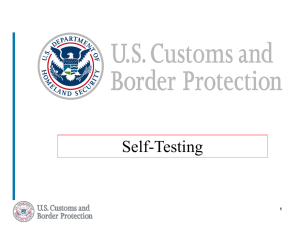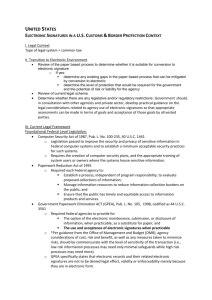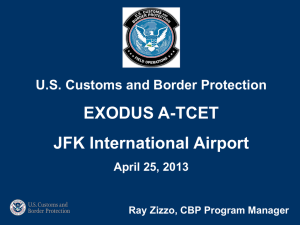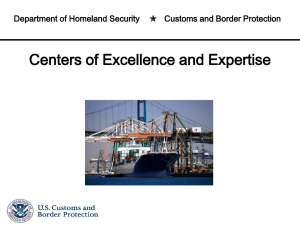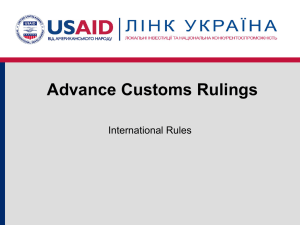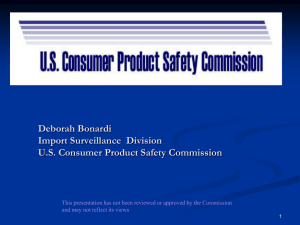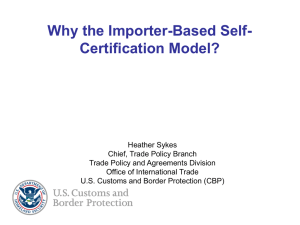Environmental Protection Agency Toxic Substances Control Act
advertisement
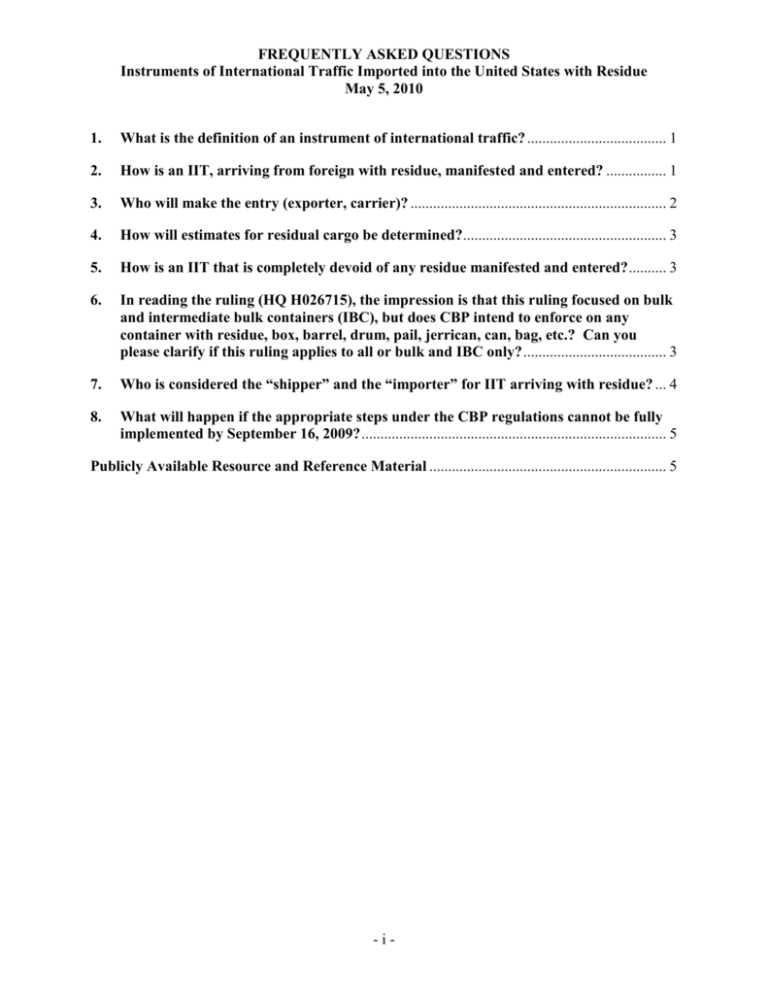
FREQUENTLY ASKED QUESTIONS
Instruments of International Traffic Imported into the United States with Residue
May 5, 2010
1.
What is the definition of an instrument of international traffic? ..................................... 1
2.
How is an IIT, arriving from foreign with residue, manifested and entered? ................ 1
3.
Who will make the entry (exporter, carrier)? .................................................................... 2
4.
How will estimates for residual cargo be determined? ...................................................... 3
5.
How is an IIT that is completely devoid of any residue manifested and entered? .......... 3
6.
In reading the ruling (HQ H026715), the impression is that this ruling focused on bulk
and intermediate bulk containers (IBC), but does CBP intend to enforce on any
container with residue, box, barrel, drum, pail, jerrican, can, bag, etc.? Can you
please clarify if this ruling applies to all or bulk and IBC only? ...................................... 3
7.
Who is considered the “shipper” and the “importer” for IIT arriving with residue? ... 4
8.
What will happen if the appropriate steps under the CBP regulations cannot be fully
implemented by September 16, 2009? ................................................................................. 5
Publicly Available Resource and Reference Material ............................................................... 5
-i-
FREQUENTLY ASKED QUESTIONS
Instruments of International Traffic Imported into the United States with Residue
May 5, 2010
U.S. Customs and Border Protection (CBP) has received numerous questions concerning the
importation of instruments of international traffic with residue. CBP prepared this document to
assist the trade community in understanding the obligations for transporting carriers concerning
the advance electronic cargo information and importers for entry requirements. Please continue
to monitor this document for changes and updates.
1. What is the definition of an instrument of international traffic?
Section 322(a), Tariff Act of 1930, as amended (19 U.S.C. 1322(a)), provides that
"[v]ehicles and other instruments of international traffic (IIT), of any class specified by
the Secretary of the Treasury, shall be granted the customary exceptions from the
application of the customs laws to the extent and subject to such terms and conditions as
may be prescribed in regulations or instructions of the Secretary of the Treasury."
To qualify as an IIT within the meaning of section 322(a), Tariff Act of 1930, as
amended (19 U.S.C. 1322(a)), and the regulations issued thereunder (19 CFR 10.41a et
seq.), an article must be substantial, suitable for and capable of repeated use, and used in
significant numbers in international traffic. The CBP Regulations issued under the
authority of section 322(a) are in section 10.41a (19 CFR 10.41a). Paragraph (a)(1) of
section 10.41a designates as IIT lift vans, cargo vans, shipping tanks and certain other
named articles and states that other articles may be designated as IIT by the
Commissioner of Customs in decisions to be published in the weekly Customs Bulletin.
Articles qualifying for treatment as IIT are considered to be used in international traffic
when they arrive containing merchandise and when they arrive empty to be filled with
merchandise to be exported foreign.
2. How is an IIT, arriving from foreign with residue, manifested and entered?
An IIT arriving from a foreign port or place with residue may not be manifested or
entered as an empty container. The residue must be manifested, classified, and entered in
accordance with statutes and regulations enforced by CBP.
Proof of
Type 3A
Type 1
Value of
Value
Bond
Bond
Residue
Required Entry Type*
Required Required
≥ $2,000.00
Y
Formal Entry
Y
Y
< $2,000.00
Y
Informal Entry
Y
N
<200.00
Y
19 U.S.C. 1321
Y
N
*May be subject to other Federal agency license, permit, and/or
restriction (e.g., DOT, EPA TSCA, FDA PN)
-1-
FREQUENTLY ASKED QUESTIONS
Instruments of International Traffic Imported into the United States with Residue
May 5, 2010
A CBP bond type 3A is required for all instruments of international traffic (19 CFR
113.66), and they should be entered under 9801.00.10 or 9803.00.50, HTSUS. The
residual chemicals may be filed as an informal type 11 or under 19 USC 1321 for
administrative exemptions, which would eliminate the Type 1 Importer or Broker bond
requirement for the residue. A type 3A bond will be obligated for the CBP Form 3461,
with two lines - one using the 9801.00.10 or 9803.00.50 HTS and the other using the
correct classification of the chemicals with the correct value.
3. Who will make the entry (exporter, carrier)?
When a shipment reaches the United States, the importer of record (i.e., the owner,
purchaser, or licensed customs broker designated by the owner, purchaser, or consignee)
will file entry documents for the goods with the port director at the goods' port of entry.
Imported goods are not legally entered until after the shipment has arrived within the port
of entry, delivery of the merchandise has been authorized by CBP, and estimated duties
have been paid. It is the importer of record's responsibility to arrange for examination and
release of the goods. 19 U.S.C. 1484 provides:
(a) Requirement and time
(1) Except as provided in sections 1490, 1498, 1552, and 1553 of this title,
one of the parties qualifying as “importer of record” under paragraph
(2)(B), either in person or by an agent authorized by the party in writing,
shall, using reasonable care—
(A) make entry therefor by filing with the Bureau of Customs and Border
Protection such documentation or, pursuant to an authorized
electronic data interchange system, such information as is necessary
to enable the Bureau of Customs and Border Protection to determine
whether the merchandise may be released from custody of the Bureau
of Customs and Border Protection;
(B) complete the entry, or substitute 1 or more reconfigured entries on an
import activity summary statement, by filing with the Customs
Service the declared value, classification and rate of duty applicable
to the merchandise, and such other documentation or, pursuant to an
electronic data interchange system, such other information as is
necessary to enable the Customs Service to—
(i) properly assess duties on the merchandise,
(ii) collect accurate statistics with respect to the merchandise, and
(iii) determine whether any other applicable requirement of law
(other than a requirement relating to release from customs
custody) is met.
Thus, any party that can meet the definition cited above for importer of record may make
entry on the residue within a container.
-2-
FREQUENTLY ASKED QUESTIONS
Instruments of International Traffic Imported into the United States with Residue
May 5, 2010
4. How will estimates for residual cargo be determined?
Since the exact amount of the residual goods may not be known at the time the advance
cargo information is required to be transmitted, the importer may estimate the amount
when providing that information to the carrier for transmission to CBP. Mathematical
calculations, volume and weight readings, and historical data may all be tools used in
estimating the amount of residue within a container. Additionally, the same estimated
amount should be used at the time of entry of the goods. If a more precise amount is
obtained after arrival then manifested quantity must be amended by the carrier and the
entry must be amended by the filer. Under existing statutes and regulations, the
transporting carrier is responsible for corrections to manifested quantities and the entry
filer is responsible for corrections to the entry. Failure to effect corrections within time
limits prescribed by the existing statutes and regulations may result in the initiation of an
enforcement action by the CBP port director.
5. How is an IIT that is completely devoid of any residue manifested and entered?
IIT arriving empty may be released without entry or the payment of duty, subject to the
provisions of section 10.41a (19 CFR 10.41a). Under the provisions of section 10.41a(c)
of the CBP Regulations, an IIT will be released only after a bond has been filed on
Customs Form 301 containing the bond conditions required under section 113.66 of the
CBP (19 CFR 113.66). The principal on the IIT (Type 3A) bond must be the applicant
for release of the holder or container designated as an IIT.
6. In reading the ruling (HQ H026715), the impression is that this ruling focused on bulk
and intermediate bulk containers (IBC), but does CBP intend to enforce on any
container with residue, box, barrel, drum, pail, jerrican, can, bag, etc.? Can you please
clarify if this ruling applies to all or bulk and IBC only?
To the extent that the original ruling (HQ 113129 dated July 12, 1994) applied to Dow
Corning, and those containers at issue within the ruling, all other entities should have
been transmitting advance electronic cargo information and properly entering the
merchandise and containers that have been transported into the United States.
The CBP regulations (available online at http://www.access.gpo.gov/nara/cfr/cfr-tablesearch.html#page1) 19 CFR 177.9(c) provide:
(c) Reliance on ruling letters by others. Except when public notice and
comment procedures apply under Sec. 177.12, a ruling letter is subject to
modification or revocation by CBP without notice to any person other than the
person to whom the ruling letter was addressed. Accordingly, no other person
should rely on the ruling letter or assume that the principles of that ruling
will be applied in connection with any transaction other than the one
described in the letter. However, any person eligible to request a ruling under
Sec. 177.1(c) may request information as to whether a previously-issued ruling
-3-
FREQUENTLY ASKED QUESTIONS
Instruments of International Traffic Imported into the United States with Residue
May 5, 2010
letter has been modified or revoked by writing the Commissioner of Customs
and Border Protection, Attention: Regulations and Rulings, Office of
International Trade, Washington, DC 20229, and either enclosing a copy of the
ruling letter or furnishing other information sufficient to permit the ruling letter
in question to be identified.
Section 141.4, Customs Regulations (19 CFR 141.4), provides that entry as required by
title 19, United States Code, section 1484(a) {19 U.S.C. 1484(a)}, shall be made of every
importation whether free or dutiable and regardless of value, except for intangibles and
articles specifically exempted by law or regulations from the requirements for entry.
7. Who is considered the “shipper” and the “importer” for IIT arriving with residue?
The Required Advance Electronic Presentation of Cargo Information Final Rule was
published in the Federal Register on December 5, 2003. Pursuant to section 343(a)(1) of
the Trade Act of 2002 (as amended by section 108 of the Maritime Transportation
Security Act of 2002), cargo information must be transmitted to CBP by means of a
CBP-approved electronic data interchange system for all modes of transportation prior to
import into or export from the United States. The shipper data element is identified in the
Trade Act regulations for each mode of transportation as follows:
Vessel regulations, 19 CFR 4.7
Air regulations, 19 CFR 122.48a
Rail regulations, 19 CFR 123.91
Truck regulations, 19 CFR 123.92.
On February 23, 2004, CBP published a press release regarding shipper requirements
under the Trade Act of 2002 implementing regulations. This document is available on
the CBP website at
http://www.cbp.gov/xp/cgov/newsroom/news_releases/archives/2004_press_releases/022
004/02232004.xml. CBP has agreed to use the 24-Hour rule definition of shipper until
the issue is resolved. Under the 24-Hour rule, the party that contracts for carriage of the
cargo is acceptable in the shipper field. However, a CBP officer may place the shipment
on hold or issue a Do Not Load until s/he can identify additional, specific information
regarding the parties involved.
When a formal entry of merchandise is made under the provisions of 19 U.S.C. 1484, the
required documentation or information is required to be filed or electronically transmitted
by the importer of record. Under the statute, the importer of record is either the owner or
purchaser of the merchandise or, when appropriately designated by the owner, purchaser,
or consignee of the merchandise, a person holding a valid license as a customs broker. As
part of the entry process, goods must be classified (determined where in the U.S. tariff
system they fall) and their value must be determined.
Pursuant to the Customs Modernization Act, it is the responsibility of the importer of
record to use reasonable care to enter, classify, and value the goods, and provide any
-4-
FREQUENTLY ASKED QUESTIONS
Instruments of International Traffic Imported into the United States with Residue
May 5, 2010
other information necessary to enable CBP to properly assess duties, collect accurate
statistics, and determine whether all other applicable legal requirements are met. These
requirements can be complex. In order to assist importers in meeting their
responsibilities, importers may employ experts within their organizations or seek advice
or services from outside experts such as customs brokers, attorneys who specialize in
customs matters or consultants. Of these outside experts, only customs brokers may
actually prepare and file entry documentation, because the preparation and filing of entry
documentation constitutes “customs business” which, by statute, may be performed on
behalf of others only by a licensed customs broker.
8. What will happen if the appropriate steps under the CBP regulations cannot be fully
implemented by September 16, 2009?
CBP has delayed enforcement until further notice in order for the trade community to
fully comply with these requirements. Once a definitive enforcement date is established:
Instruments of international traffic containing residual chemicals, cargo, goods,
etc., must be manifested and entered in compliance with customs laws;
If qualified, shipments containing residual goods can be entered as American
Goods Returned (AGR); and
Since the exact amount of the residual goods may not be known at the time the
advance cargo information is required to be transmitted, the importer may
estimate the amount when providing that information to the carrier for
transmission to CBP. Additionally, the same estimated amount should be used at
the time of entry of the goods. If a more precise amount is obtained after arrival
then the entry should be amended.
Publicly Available Resource and Reference Material
Environmental Protection Agency Toxic Substances Control Act (TSCA) Importing and
Exporting Requirements
• http://www.epa.gov/oppt/import-export/
Food Drug Administration Prior Notice of Imported Foods under the Bioterrorism Act of
2002
• http://www.fda.gov/Food/FoodDefense/Bioterrorism/PriorNotice/default.htm
Customs and Border Protection
Basic Importing and Exporting
• http://www.cbp.gov/xp/cgov/trade/basic_trade/
Importing into the United States
Informed Compliance Publications
• http://www.cbp.gov/xp/cgov/trade/legal/informed_compliance_pubs/
Bona Fide Sales and Sales for Exportation to the United States
-5-
FREQUENTLY ASKED QUESTIONS
Instruments of International Traffic Imported into the United States with Residue
May 5, 2010
Customs Administrative Enforcement Process: Fines, Penalties, Forfeitures, and
Liquidated Damages
Customs Brokers
Customs Value
CROSS – Customs Ruling Online Search System
• http://rulings.cbp.gov/
Ruling Request – 19 CFR Part 177
• http://www.cbp.gov/xp/cgov/trade/legal/rulings/ruling_letters.xml
CBP Bulletins and Decisions
• http://www.cbp.gov/xp/cgov/trade/legal/bulletins_decisions/
Trade Act of 2002 – Advance Electronic Cargo Information Requirements
http://www.cbp.gov/xp/cgov/trade/trade_outreach/advance_info/
ACE Truck e-Manifest
• http://www.cbp.gov/xp/cgov/trade/automated/modernization/carrier_info/electronic_t
ruck_manifest_info/
-6-
